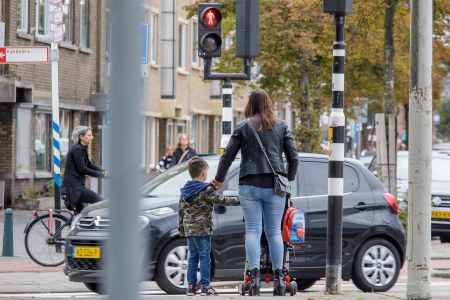The role of the school
School is a logical place to provide traffic education because it offers the opportunity to provide traffic education to all children and to ensure that all children are imparted with the same knowledge, and taught the same skills, attitudes, norms and values, regardless of parents' considerations and (socioeconomic) opportunities [1].
In the Netherlands, traffic is a compulsory part of the primary school curriculum. Together with geography, history, biology, citizenship and political studies, they are part of the subject World orientation/self-orientation. How often and how much time should be spent on the subject of traffic is not fixed. This is left to the discretion of schools [6].
In secondary education, traffic is not a compulsory subject, but (a small) part of two of the 58 educational core goals for lower secondary education [7]:
- In the Human and Nature domain, core goal 35 is: "pupils learn about health and learn to take care of themselves, others and their environment, and how to positively influence their own and others’ safety in various living conditions (residing, learning, working, going out, traffic)."
- In the Human and Society domain, core goal 45 is: "Pupils learn - by experience and in their own environment - to recognise the effects of choices in the areas of work and health, living and recreation, consuming and budgeting, traffic and environment."
Traffic/traffic participation is not included in the so-called attainment targets for upper secondary education.
There are several teaching programmes available for primary and lower secondary education. The Toolkit LifelongTraffic education [8] offers a compact overview of Dutch programmes. Through various filters teachers may search specifically by age group, school type, subject etcetera. The programmes are developed and offered by various agencies, including ANWB, TeamAlert, VeiligheidNL and VVN.
The role of parents/caregivers
Parents also have a role in imparting knowledge and teaching their children road safety skills. This usually does not happen in the form of a programme or project as done at school, but in a more informal way, in everyday life. For example, parents can point out possible hazards to their children during the route from home to school or while driving draw their attention to certain situations or behaviour [9]. Parents/caregivers can also act as models for their children by leading by example. Informal education begins with children who do not yet go to school independently. But also, when children do go to school independently, parents can still have a positive influence on the risk behaviour of their children. Good communication is especially important with somewhat older children (adolescents) [10].
The role of parents/caregivers in 'accompanied driving for novice drivers (in the Netherlands called 2todrive) is also a form of informal traffic education. A parent or other person travels with the novice driver for a certain period of time, so that the novice driver gains driving experience in a relatively protected environment. For more information, see SWOV fact sheet Driver training and driving tests.
